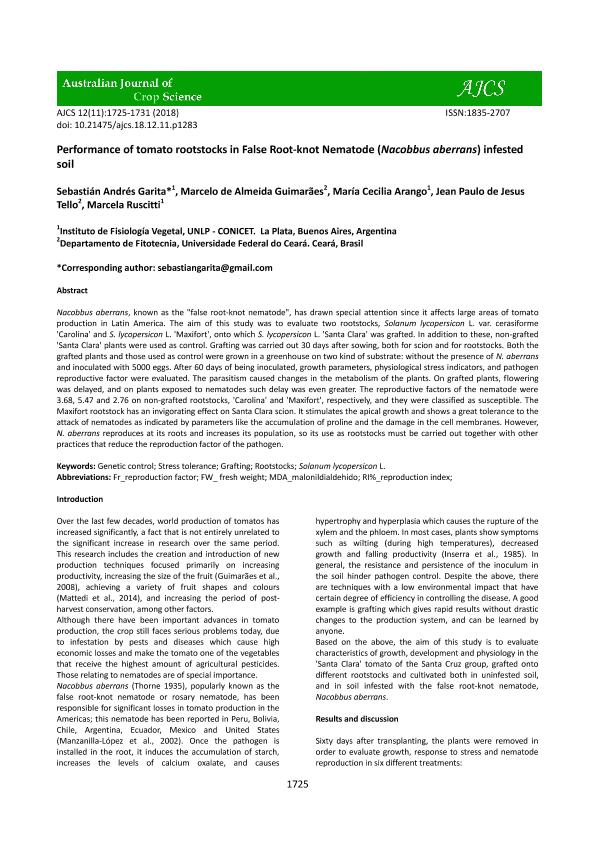Mostrar el registro sencillo del ítem
dc.contributor.author
Garita, Sebastián Andrés

dc.contributor.author
Almeida Guimaraes, Marcelo de
dc.contributor.author
Arango, María Cecilia

dc.contributor.author
Tello, Jean Paulo de Jesus
dc.contributor.author
Ruscitti, Marcela
dc.date.available
2020-01-03T15:04:37Z
dc.date.issued
2018-11
dc.identifier.citation
Garita, Sebastián Andrés; Almeida Guimaraes, Marcelo de; Arango, María Cecilia; Tello, Jean Paulo de Jesus; Ruscitti, Marcela; Performance of tomato rootstocks in False Root-knot Nematode (Nacobbus aberrans) infested soil; Southern Cross Publishing; Australian Journal of Crop Science; 12; 11; 11-2018; 1725-1761
dc.identifier.issn
1835-2693
dc.identifier.uri
http://hdl.handle.net/11336/93380
dc.description.abstract
Nacobbus aberrans, known as the "false root-knot nematode", has drawn special attention since it affects large areas of tomato production in Latin America. The aim of this study was to evaluate two rootstocks, Solanum lycopersicon L. var. cerasiforme ´Carolina´ and S. lycopersicon L. ´Maxifort´, onto which S. lycopersicon L. ´Santa Clara´ was grafted. In addition to these, non-grafted ´Santa Clara´ plants were used as control. Grafting was carried out 30 days after sowing, both for scion and for rootstocks. Both the grafted plants and those used as control were grown in a greenhouse on two kind of substrate: without the presence of N. aberrans and inoculated with 5000 eggs. After 60 days of being inoculated, growth parameters, physiological stress indicators, and pathogen reproductive factor were evaluated. The parasitism caused changes in the metabolism of the plants. On grafted plants, f lowering was delayed, and on plants exposed to nematodes such delay was even greater. The reproductive factors of the nematode were 3.68, 5.47 and 2.76 on non-grafted rootstocks, ´Carolina´ and ´Maxifort´, respectively, and they were classified as suscepti ble. The Maxifort rootstock has an invigorating effect on Santa Clara scion. It stimulates the apical growth and shows a great tolerance to the attack of nematodes as indicated by parameters like the accumulation of proline and the damage in the cell membranes. However, N. aberrans reproduces at its roots and increases its population, so its use as rootstocks must be carried out together with other practices that reduce the reproduction factor of the pathogen.
dc.format
application/pdf
dc.language.iso
eng
dc.publisher
Southern Cross Publishing

dc.rights
info:eu-repo/semantics/openAccess
dc.rights.uri
https://creativecommons.org/licenses/by-nc-sa/2.5/ar/
dc.subject
GENETIC CONTROL
dc.subject
STRESS TOLERANCE
dc.subject
GRAFTING
dc.subject
ROOTSTOCK
dc.subject.classification
Horticultura, Viticultura

dc.subject.classification
Agricultura, Silvicultura y Pesca

dc.subject.classification
CIENCIAS AGRÍCOLAS

dc.title
Performance of tomato rootstocks in False Root-knot Nematode (Nacobbus aberrans) infested soil
dc.type
info:eu-repo/semantics/article
dc.type
info:ar-repo/semantics/artículo
dc.type
info:eu-repo/semantics/publishedVersion
dc.date.updated
2019-10-18T18:31:29Z
dc.identifier.eissn
1835-2707
dc.journal.volume
12
dc.journal.number
11
dc.journal.pagination
1725-1761
dc.journal.pais
Australia

dc.description.fil
Fil: Garita, Sebastián Andrés. Consejo Nacional de Investigaciones Científicas y Técnicas. Centro Científico Tecnológico Conicet - La Plata. Instituto de Fisiología Vegetal. Universidad Nacional de La Plata. Facultad de Ciencias Naturales y Museo. Instituto de Fisiología Vegetal; Argentina
dc.description.fil
Fil: Guimaraes Marcelo.
dc.journal.title
Australian Journal of Crop Science

dc.relation.alternativeid
info:eu-repo/semantics/altIdentifier/url/https://www.cropj.com/garita_12_11_2018_1725_1731.pdf
dc.relation.alternativeid
info:eu-repo/semantics/altIdentifier/doi/http://dx.doi.org/10.21475/ajcs.18.12.11.p1283
dc.relation.alternativeid
info:eu-repo/semantics/altIdentifier/url/https://www.cropj.com/november2018.html
Archivos asociados
